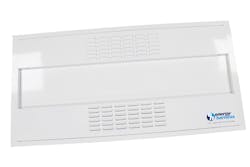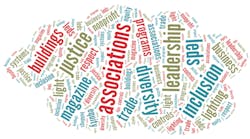Purdue University and LED lighting manufacturer Energy Harness Corp. have announced a ceiling-mounted ultraviolet (UV) system called Active-Airflow that is intended to deactivate pathogens including the novel coronavirus. Energy Harness has an active affiliation with Purdue and operates an office in the Purdue Research Park of Indianapolis that’s managed by the Purdue Research Foundation. Energy Harness intends to have systems available for two Central Indiana school districts before classes restart.
We continue to see many questionable germicidal UV or UV disinfection concepts touted, especially some that ignore the potential danger of the UV-C (100–280-nm) radiation to human skin and eyes. Moreover, a number of industry organizations have weighed in on the matter with a position paper. The Energy Harness approach seems to be inherently safe with the UV-C LEDs integrated inside the unit where air is treated while the design contains the dangerous radiation.
The integration of UV-C sources in air-circulation systems has great promise, especially given the growing knowledge about the dangers of airborne spread of the coronavirus. One obvious possibility is installing UV-C systems in HVAC equipment, and Utility TVA is offering incentives for customers that install such systems. The Energy Harness approach is independent of the HVAC system, but still uses active air handling to draw room air into the unit.
The standalone approach of the disinfection system could make it simpler for some facilities to install. The unit is designed to lay into a grid ceiling much like a troffer luminaire. And the system will connect into the ceiling power grid that already exists to power the lighting. The concept is safety for people in a space and continuous disinfection of the space.
“We have demonstrated and studies have shown the effectiveness of UV-C light in killing the COVID-2 family of pathogens,” said Patricio M. Daneri, managing director of Energy Harness’ Midwest division. “Our Active-Airflow unit provides the added advantage of safe usage during the school day in occupied classrooms. The unit has a fan system to draw in the air, where it is cleaned and then cycled back into the room.”
Energy Harness has posted some specifications for the Active-Airflow system on its website. The LEDs in the unit radiate in the 260–280-nm range — wavelengths known to have germicidal efficacy. Ultimately, germicidal efficacy is based on UV-C dosage, which is a function of UV-C power per area multiplied by exposure time. So in this instance, the key factors would be the radiometric output of the UV-C LEDs (168W) and the airflow (116 CFM).
The company states the UV dosage to be 12,000 to 18,000. We asked for a clarification of that range but had not received an answer at press time. We presume that specification is in µWs/cm2 (microwatt second per square centimeter). It could also be expressed as 12–18 mJ/cm2 (millijoule per square centimeter.) Energy Harness said that each unit can disinfect a 256-ft2 space. That would typically mean multiple units in each classroom in a school setting.
We did submit questions to Energy Harness as to the LEDs used in the Active-Airflow units. Knowing the state of the UV-C LED technology, we’d presume the need for hundreds of LEDs. We will update the story if we receive any details from the company.
The Active-Airflow system is being installed in schools that are part of the Beech Grove City Schools and Franklin Township Community Schools districts in Indiana. “We have had success working with the Energy Harness team before and are excited about this new technology product to help keep our community safe,” said Tom Gearhart, director of operations for the Beech Grove City Schools.
For more background on the use of UV-C energy in disinfection applications, see our June webcast on the topic. You can register for free and watch the one-hour presentation on demand. Also see our technology feature by LED and semiconductor consultant Mike Krames on the technology roadmap for UV-C LEDs.
For up-to-the-minute LED and SSL updates, why not follow us on Twitter? You’ll find curated content and commentary, as well as information on industry events, webcasts, and surveys on our LinkedIn Company Page and our Facebook page.





